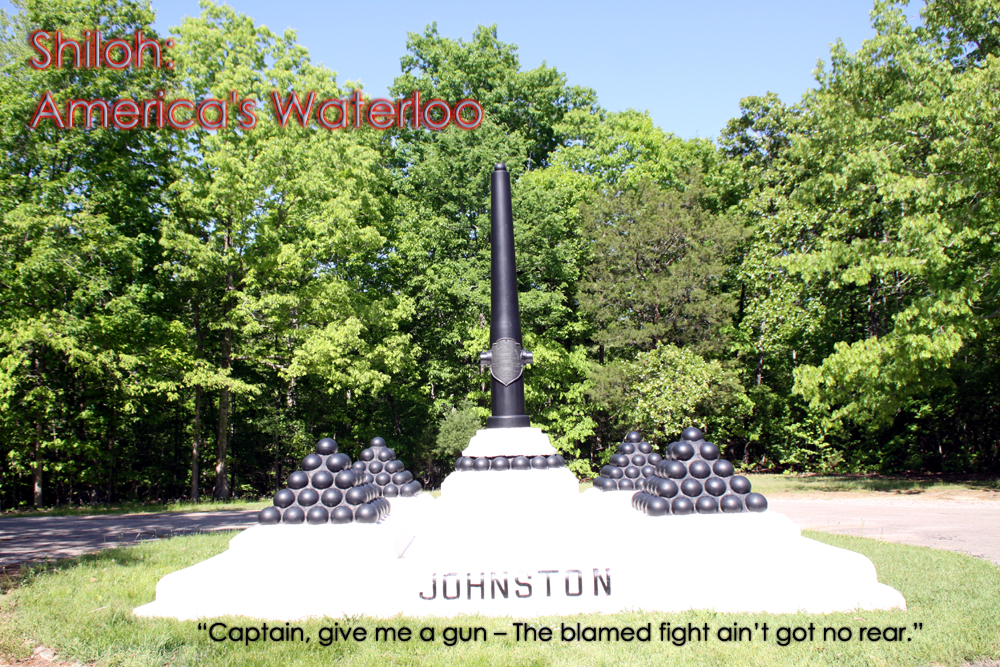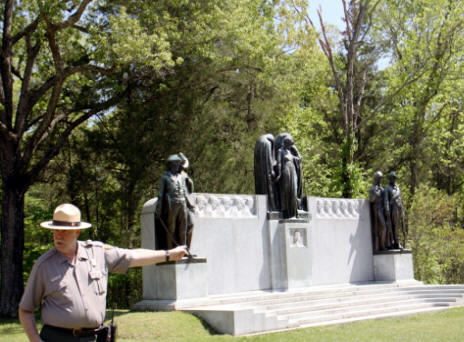|

This was the conclusion of an unknown Ohio
private who had tried to flee to safety during the Battle of
Shiloh. He decided he had to stay and fight since he observed in
this battle, there was no refuge to retreat into, no rear to
hide a frightened man. The battle was everywhere at once.
 |
| Charlie Spearman explains the Confedeate Memorial |
The Shiloh Battlefield National Park is much like the battle
itself, spread out over almost 6,000 acres counting the Corinth
portion.There is a
12.7 mile auto tour route that takes you through the battlefield
with 20 marked stops along the route. We started at the Visitor
Center viewing Shiloh -
Fiery Trial, a moving documentary showing the battle from
multiple viewpoints. The most heart rendering being two young
soldiers, one Confederate and one Union. It's a new movie which
premiered in 2012. Several of the park rangers portray
characters in the movie.
Shiloh Battlefield is a must see for any
history buff. Plan on spending the better part of a day at
least. Charlie Spearman, our park ranger guide, told us "This is
one of the most pristine Civil War battlefields you will ever
see."
He led us across the park. He pointed out
some things of which you want to be aware. Pyramids of cannon
balls mark locations of headquarters of commanders of various
brigades and divisions.
 |
| Manse George Cabin, only
surviving structure from the battle |
One point about Shiloh is the composition of the armies here.
For the Confederacy, you have General Albert Sidney Johnston,
the second highest ranking man in the Confederate army. He
outranks Robert E. Lee at this point. Almost anyone will
recognize another name here, General P. T.G. Beauregard, who won his fame at Fort
Sumter and Manassas.
Another
name that will go down in history later is Henry Morton Stanley.
Doesn't ring a bell? Let me give you a clue: Dr Livingston I
presume. Stanley was a reluctant soldier to say the least. He
joined the Confederate
Army and found himself at Shiloh only after receiving several
ladies petticoats in his mail from friends who doubted his
patriotism. After being
taken prisoner he
switched uniforms at Camp Douglas, Illinois, to become a
"Galvanized Yankee" and joined the Union Army for a short time,
18 days, but was discharged because of illness. He later joined
the Union Navy making him the only man to serve in the
Confederate Army, the Union Army and the Union Navy all in one
war.
The Union brass include two future
presidents, General Ulysses S. Grant and Major General James A. Garfield.Major General Lewis "Lew" Wallace, who won fame later for
his novels, did not acquit himself well at the battle and his
military reputation suffered for his mistakes throughout the
remainder of the war. Of course, Grant and Sherman cemented a long
term friendship.
Among the rank and file, 70% of the
soldiers had never seen action at this point. Many would never
see action again. When the smoke cleared there were over 23,000
casualties.
We walked down to Pittsburg Landing. (#19
on the auto tour) This was the Union encampment. There would have been numerous
steamboats lined up bringing in supplies and troops and two
gunboats for protection. Grant was the commander here. He had
gotten lots of praise for his victories at Fort Donaldson and
Fort Henry where he demanded and received what became his
nickname, Unconditional Surrender Grant.
All of the Union generals were convinced
Johnston was going to stay put in Corinth as that was an
important railroad stronghold. The Confederate attack of April
6, when the Rebels burst out to the woods near Shiloh Church
(#5) at a place called Fraley Field (#7),
took them by total
surprise.
Although, Sherman and Grant were not
expecting an attack, one field commander, Col. Everett Peabody, was not so sure that the Union pickets
reporting a buildup of Confederates was wrong. On his own
initiative, he sent out an advance guard of around 200 men to
check. It was these men that triggered the first Confederate
gunfire. It was still dark and both groups are firing
smooth-bore muskets. Not very precise under those conditions.
The rest of the Union Army, including its commanding officers,
were taken totally by surprise. Many of the Union soldiers retreated back to Pittsburg
Landing and attempt to swim away and escape.
 |
| The reconstructed Shiloh
Church |
Shiloh Church is one of my favorite spots in the battlefield.
The church is so simple and peaceful yet the number of dead at
this battlefield was the greatest loss up to this point in
American history.
Move on to the place where the South paid the highest price and lost
their commander, General Johnston (#15). Many years earlier,
Johnston had been wounded in his right leg and has no feeling in
that leg. That played a big part in his death.
Here at Shiloh, Johnston was wounded in the same leg and
bled to death. Probably he was not aware of the wound.
Beauregard took command.
We then visited the Confederate Memorial
(#2 on the tour).
This is where the Confederates almost won their victory
when they captured about 2,100 defenders of what is
called the Hornet's Nest (#10). Beauregard sent a telegram to
Jefferson Davis stating they had achieved "a completer victory."
(Oh the woes of jumping the gun literally.)
April 7th saw a different scenario.
Beauregard thinks the Union army might retreat during the night.
Instead, the Union Army gets reinforced and from the start of
battle on the 7th, they take the inisitive and drive back the
confederates. Beauregard realized it is his army that must
retreat or be destroyed completely here. He marches his men back
to Corinth even though they had lost less men, giving up Shiloh makes this a Union victory, albeit a
costly one. The Union loses 13,047 men. 1754 are killed and
8,408 wounded with another 2,885 captured or missing. The
Confederacy loses 10,699 men. 1,728 are
killed and 8,012
wounded with another 959 captured or missing.
Those who were previously predicting a short war now
realize is will be longer and costively than anyone imagined.
The nightmare was just beginning.
Shelby
Foote, writing of the Battle of Shiloh in The
Civil War: A Narrative: Fort Sumter to Perryville, referred to the Battle of Shiloh
thusly, "Waterloo had settled something, while
this one apparently had settled nothing. When it was over the
two armies were back where they started, with other Waterloos
ahead"
For more info:
http://www.nps.gov/shil/index.htm
|
![]() Ads fund American Roads so please consider them for your needed
purchases.
If you enjoy the articles we offer, donations
are always welcome.
Ads fund American Roads so please consider them for your needed
purchases.
If you enjoy the articles we offer, donations
are always welcome.
|